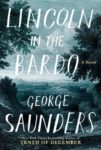On the Rise: Saunders’s Debut Novel
 The debut novel by acclaimed short story writer George Saunders, Lincoln in the Bardo (PRH/RH; RH Audio/BOT; Overdrive Sample), is rising on Amazon in advance of its release next week.
The debut novel by acclaimed short story writer George Saunders, Lincoln in the Bardo (PRH/RH; RH Audio/BOT; Overdrive Sample), is rising on Amazon in advance of its release next week.
It has enjoyed an enviable range of critical coverage, including the cover of in the upcoming NYT Book Review written by Colson Whitehead. He says:
“It’s a very pleasing thing to watch a writer you have enjoyed for years reach an even higher level of achievement … George Saunders pulled that off with The Tenth Of December, his 2013 book of short stories. How gratifying and unexpected that he has repeated the feat with Lincoln in the Bardo, his first novel and a luminous feat of generosity and humanism.’’
The novel centers around the death of President Lincoln’s 11 year-old son Willie, who is laid to rest in a crypt in a DC graveyard populated by a number of people in a kind of limbo, including the President himself. Whitehead explains “The bardo of the title is a transitional state in Buddhism, where consciousness resides between death and the next life.”
Michiko Kakutani, in a NYT daily review published today, says the novel is like:
“a weird folk art diorama of a cemetery come to life. Picture, as a backdrop, one of those primitively drawn 19th-century mourning paintings with rickety white gravestones and age-worn monuments standing under the faded green canopy of a couple of delicately sketched trees. Add a tall, sad mourner, grieving over his recently deceased son. And then, to make things stranger, populate the rest of the scene with some Edward Gorey-style ghosts, skittering across the landscape — at once menacing, comical and slightly tongue-in-cheek.”
Critics compare it to multi-voiced works such as Edgar Lee Masters’s Spoon River Anthology, Thornton Wilder’s Our Town, and Sherwood Anderson’s Winesburg, Ohio. New York magazine, however, says that “polyphonic approach can be dizzying … it can be hard to follow and tricky to keep in your head” and calls the book “very, very weird” with a “premise loaded with pathos but thin on dramatic tension.”
In his ultimately positive review, Washington Post critic Ron Charles says it is “a strikingly original production, a divisively odd book bound either to dazzle or alienate readers … an extended national ghost story, an erratically funny and piteous seance of grief … [it] confounds our expectations of what a novel should look and sound like.”
Expect more to come. Already Zadie Smith has called it a “masterpiece” in a “By the Book” column in the NYT and the WSJ provides a mix of review and interview.
For such a heavily anticipated novel, libraries have ordered surprisingly few copies and are showing 1:1 holds. Those that ordered very few copies are showing ratios as high as 11:1.
